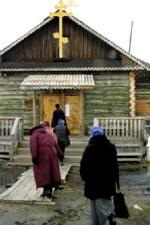
Orthodox Chapel at the North Pole
For the past several years, the liturgy has been offered at an Orthodox church situated at a Russian polar research station in Antarctica. Now, the first liturgy has been served at the North Pole. Mayor Vladislav Skvortsov of Petropavlovsk-Kamchatski was baptised at the service, and Deacon Roman Nikitin of the Missionary Department of the Diocese of Kamchatka, a young man who preaches both to the people in the local region and to a vast audience on the internet, was ordained to the priesthood in the course of this liturgy.
The hierarchical liturgy was served by His Eminence Ignaty Pologrudov of Petropavlovsk and Kamchatka. Do recall that recently he served liturgy for the crew of a submarine that was underway submerged in Arctic waters.
In addition to all this, Vladyki Ignaty became the first bishop in Russia to launch his own personal blog on the internet after a proposal was aired on the Interfax-Religion website that Orthodox believers and clergy should open blogs on the Live Journal site.
The Divine Liturgy celebrated at the North Pole was a victory for our Faith, it was a new Feast of the Triumph of Orthodoxy, and it was an illuminating example of the universality of our Orthodox faith. This shows abundantly that the Orthodox Church is the spiritual fountainhead of the Russian people. The liturgy at the North Pole was made possible by the new symphonia between the Church and the State, which resulted in closely co-ordinated efforts by the hierarchy and government. The flight to the Pole was on board one of the aircraft of the Border Forces of the Federal Security Service (FSB). This cooperation was the good fruit of the missionary efforts of the Church to those serving in the forces, especially to those defenders of the motherland on duty in the Navy and the FSB.
The magnificent future of our country, of which this liturgy at the North Pole was only a beginning, is unimaginable without a new colonisation of its territories. In the times of St Sergei of Radonezh, there was a great monastic colonisation of northeast Russia. Some 50 monasteries were founded by the disciples of St Sergei. Today, the Church must repeat this process. It would be based on the monasteries founded by those who are fleeing the world, and new cities would appear about them, as they did in the time of St Sergei. Let us remember that Russian engineering and metallurgy first appeared in the monasteries.

Holy Trinity Church in Antarctica
The monks combined their service of prayer with work on the advanced technologies of the time, and they erected smithies and power stations at Valaam and Solovki. We should follow the same course in the contemporary situation; we should encourage monastics to show practical “know-how”, to connect the mind and the heart, and to combine their prayer with useful labour.
Now, as never before, our country needs historical optimism to overcome the national and social depression that resulted from the “era of collapse”. “We were born to make a dream come true, to overcome air and space”, these words from an air force song should become our slogan for Orthodox action.
It is obvious to us that there are many millions of Muslims and Catholics in the world. Does this fact make Orthodoxy the lesser? The distinguished Russian scientist Dmitri Mendeleyev wrote in the 19th century that the population of Russia would be approximately 500 million by the end of the 20th century. The repressions of the Bolshevik Revolution and the genocide of the Nazis put paid to this estimate.
Nevertheless, we shall see a new evangelisation of Russia and a new enchurching of the Russian people. They shall give due place to God, and they shall reject secular revolutions.
Remember the words of the famous Moscow missionary priest Hegumen Sergei Rybko. Partly in earnest and partly in jest, he said,
“The Lord created other planets for Orthodox Russian colonisation. So, in our century, we may live to see not only an Arctic exarchate, but, also an exarchate on Mars. Moreover, the ascetic podvig of an Orthodox hermit in cosmic orbit would not be less than those of the early monks in the Egyptian desert”.
The authentic image of the Russian Church is found in such people as Vladyki Ignaty of Petropavlovsk and Kamchatka, rather than in those who deceive believers (or are themselves deluded) and urge Orthodox to escape from society, to hide in the Penza caves and conceal themselves, while they may and should bear witness to the Faith. Why oppose the state when it welcomes the Church and waits not only for a dialogue with it, but acts resolutely to recover the morals of our people? Therefore, a pietism that rejects missionary activity, a fancy that attempts to justify inactivity as a standard of faith on supposed ascetic, dogmatic, and canonical grounds is nothing less than anti-Church demagoguery.
Such demagoguery is impossible in Kamchatka, in the Far East of Russia. A bishop told me that until one had lived the monastic life in an ardent and authentic monastery, one was only a “parquet archimandrite”. Those such as this listen to those who search for countless pietistic excuses against missionary work in contemporary society, especially amongst the younger generation. However, if a cleric serves on the “Eastern Front”, in those regions where Orthodoxy had been annihilated in the days of communist-sponsored state atheism, he quickly realises that to restore the “meat” of the Faith he must use all the forms of Orthodox mission, including those thought “too risky” by many in other regions.
Russia’s progress and development in the 21st century is impossible without a missionary mobilisation of the Church. The hierarchical liturgy at the North Pole is an example of such a mobilisation.

Leave a Reply